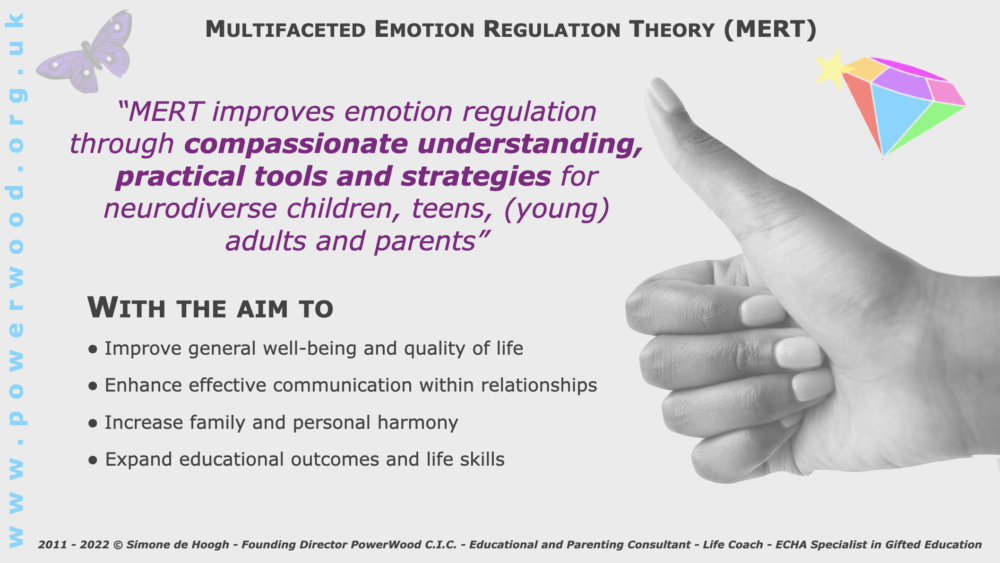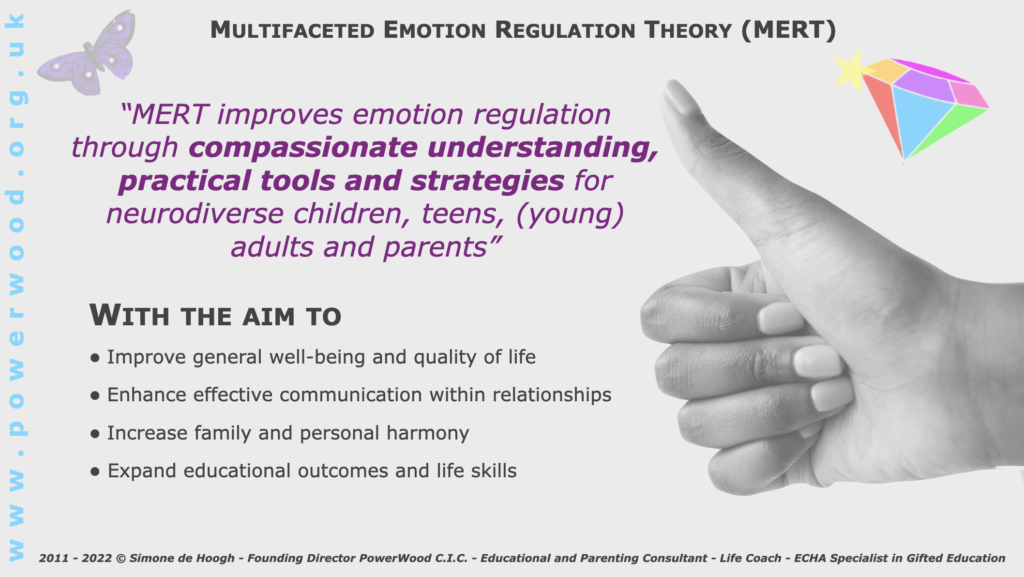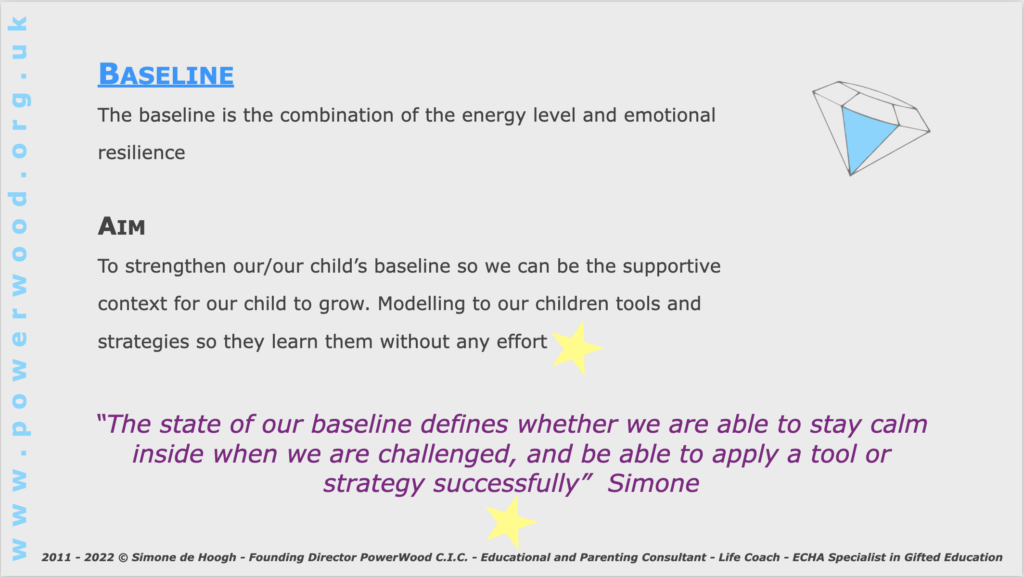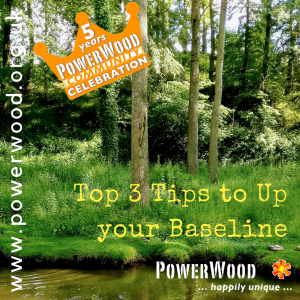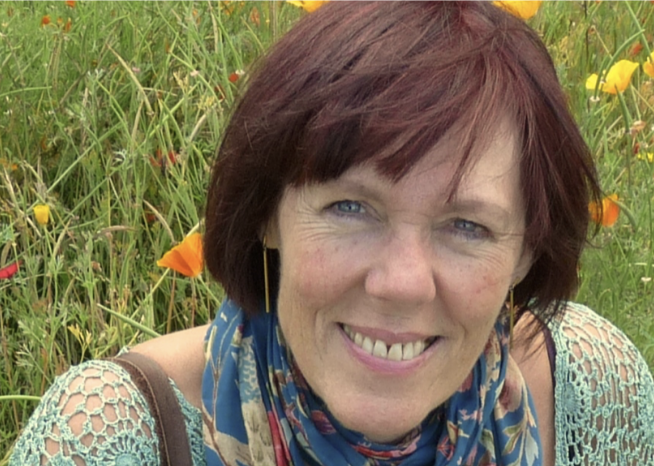 Introduction MERT
Introduction MERT
Multifaceted Emotion Regulation Theory (MERT) © Simone de Hoogh – Preliminary Version
For (More)Able Neurodiverse Children, Teens and (Young) Adults
MERT is a holistic theory developed by Simone de Hoogh. The theory explains how neurodiverse (young) individuals and parents of neurodiverse children can develop emotional regulation skills and direct their energy towards self-chosen goals, and contribute to society.
Multifaceted Emotion Regulation Theory (MERT) is based on Simone’s years of experience as a Solution Focused Coach supporting corporations through transitions, as well as her experience as a mum of two intense, sensitive and hyper-reactive children (now young adults). Further, Simone has supported neurodiverse children, teens, and (young) adults, parents, organisations and educational institutions as a life coach, family coach and an ECHA Specialist in Gifted Education (Advanced Diploma in Educating the Gifted and approved by the European Council of High Ability (ECHA)) and within PowerWood.
Neurodiversity
Multifaceted Emotion Regulation Theory is all about embracing Neurodiversity as a positive force for change in society.
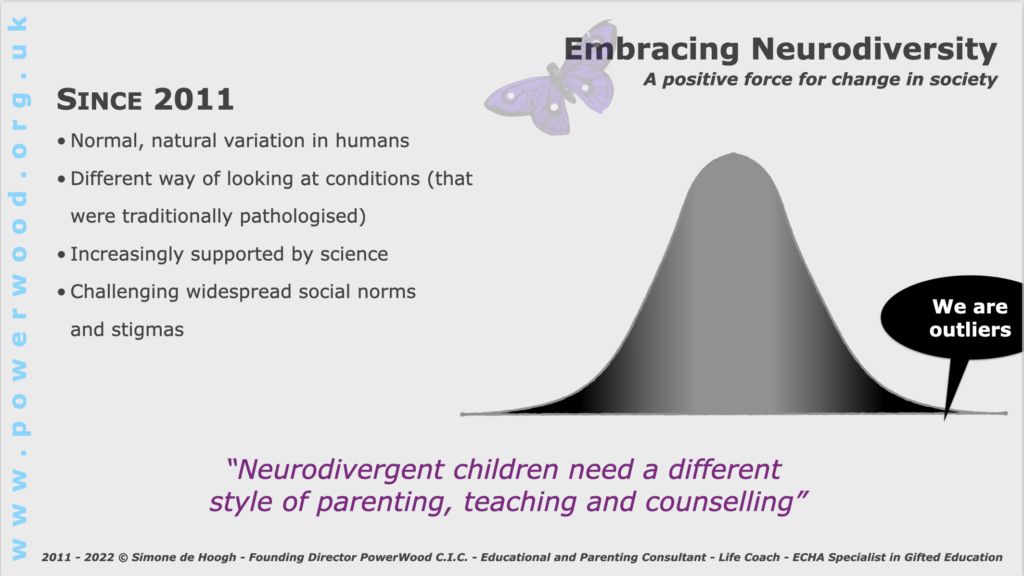
Neurodiversity is to us:
- Normal, natural variation in humans
- Different way of looking at conditions (that were traditionally pathologised)
- Increasingly supported by science
- Challenging widespread social norms and stigmas
Neurodiverse children need a different style of parenting, teaching and counselling
Multifaceted Emotion Regulation Theory (MERT)
- MERT reflects on emotions of (more)able neurodiverse individuals as qualitatively different from the norm and are expressed in different forms in different facets and can be regulated accordingly towards positive change.
- MERT aims to improve
- General well-being
- Communication
- Harmony in the (family) relationships
- Educational outcomes
- MERT aims to facilitate directing the (advanced) cognitive abilities and heightened intensity and energy towards self chosen goals.
The general aim of MERT is to Improve the quality of life by growing understanding and developing compassion.
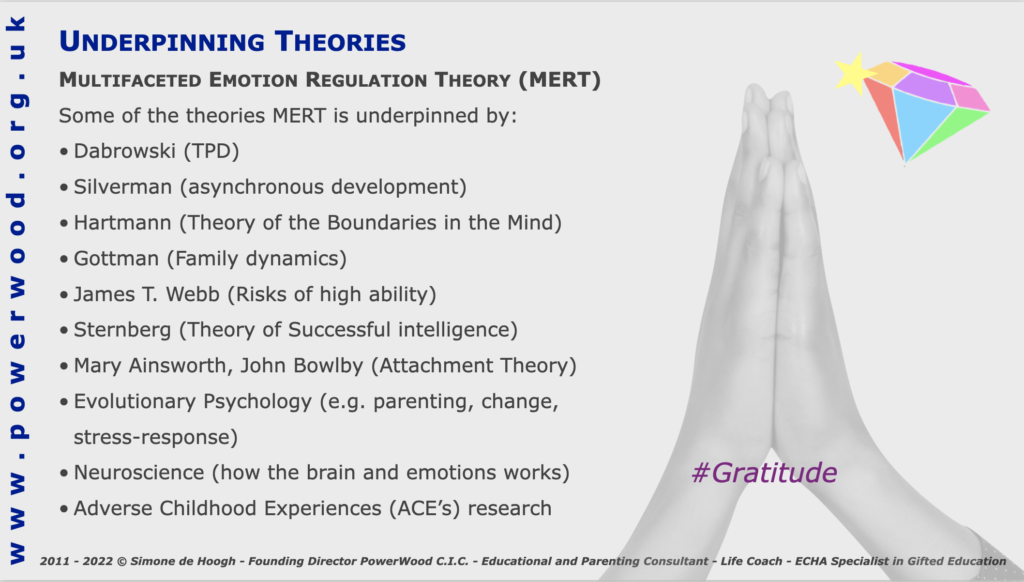
Underpinning theories of MERT
There are many theories and concepts underpinning the Multifaceted Emotion Regulation Theory. To name a few: The Theory of Positive Disintegration by Dabrowski, Asynchronous Development by Silverman, Family Dynamics by Gottman, Thickness of the Boundary in the Mind by Hartman, The Theory of Successful Intelligence by Sternberg, Risks of High-Ability by Webb, Evolutionary Psychology: parenting, change, stress response, Attachment Theory by Bowlby, Neuroscience etc.
The Multifaceted Emotion Regulation Theory (MERT) provides practical tools and strategies to apply in the heat of the moment to prevent the Cycle of Emotional and Sensory Overload and further escalation. It outlines how to strengthen the Baseline while staying compassionate towards ourselves.
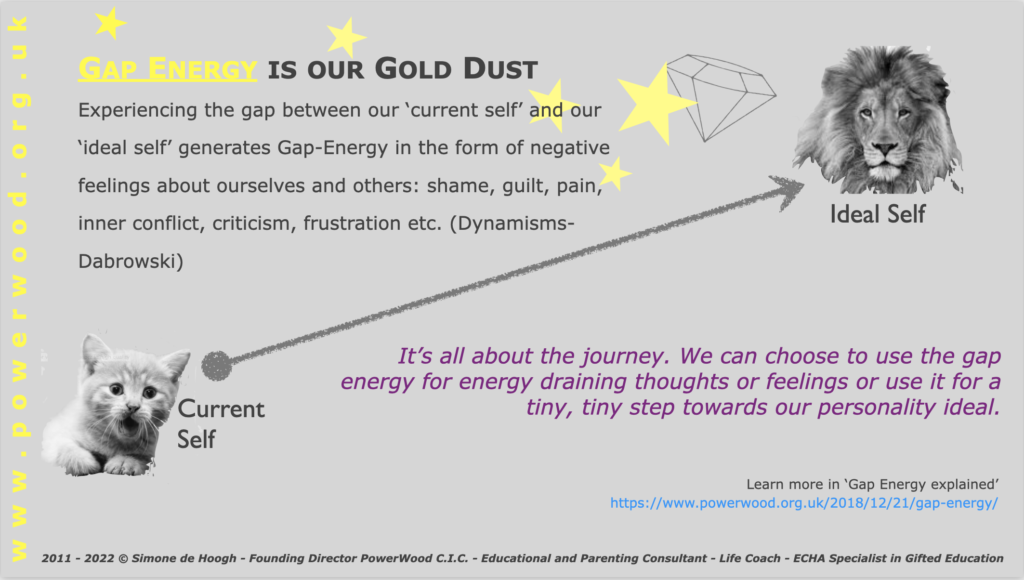
It’s all about our Journey
We can apply the MERT model to improve our own, our child’s and our other loved one’s emotional well-being.
This model describes the journey between who we are and who we would like to be, our personality ideal, acknowledging that if or we go up, our personality ideal will go up as well, we will never get there, it’s all about the journey. We use the ‘Gap Energy’ to move towards our aim.
Please be aware that in this model it’s very normal to go up and down and keep going up and down as is illustrated by the routes of the aeroplanes.
There are no clear boundaries between the different facets, and you can be at several facets at the same time. It is a very flexible model, so it’s adaptable to your personal journey. This model is based on the iterative process. The different facets are described in more detail.
We have the starting point, the runway, we move up improve our Baseline, but it might well be that something changes in personal circumstances and we have to look again at the Runway, we move up again and learn about Awareness and we have two reassess our Baseline again. Also life is not makeable and throws at us stuff this can be challenging and draining our Baseline so much that we have to go back to the Runway etc. etc.
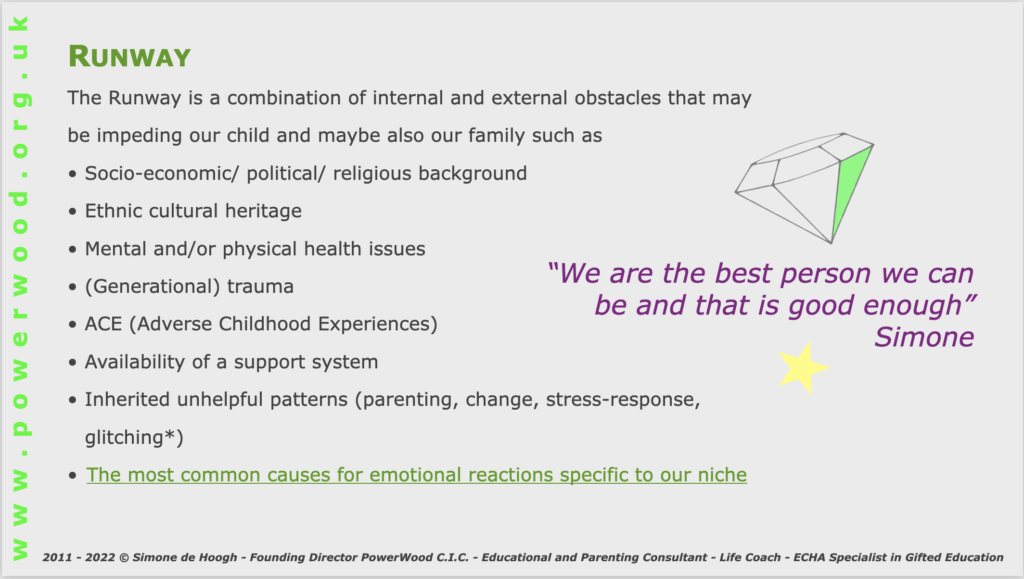
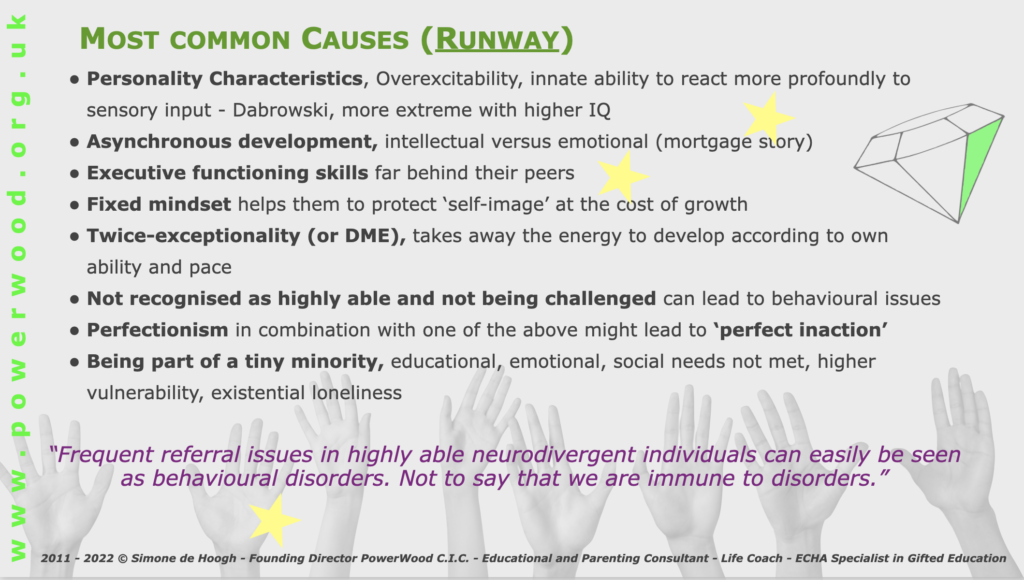
Understanding & Clearing The Runway
The journey starts with the realisation of the importance to understand where we and if applicable our child is coming from, which we call ‘The Runway’, and look at what might be obstacles on the way to be able to take off.
Clearing the runway of all unnecessary stressors or irritations is of real importance to be able to create a strong Baseline. We raise awareness and explore our own needs, and if possible we connect with our needs and limitations.
Understanding and clearing the runway is about understanding how we are evolutionarily defined in our own being, parenting, relating, our behaviour and stress responses, what our innate characteristics are, how we are influenced by our childhood experiences, how strong or fragile our support circle is with friends and family. How able are we to self-care, to repair in important relationships, what are our personal circumstances e.g. being a single mother or part of a couple, being disabled or struggling with a learning disability, battling an addiction, and how we are influenced by our economic, social and political situation e.g. how poor or rich we are and our direct environment is materially and in education, how safe economically we are, if we have just fled a war zone, or are an asylum seeker etc. etc.
This facet is about being aware and accepting ourselves and the people we love and understanding where we’re coming from and where our child is coming from and our partner, and connecting with our own needs.
“Our aim is to accept what we cannot change, find the courage to change what we can and the wisdom to see the difference.” (Serenety Prayer)
Practically this means that during life changing events small and big (e.g. new child, illness, change in family composition, loss of a loved one, getting a puppy, unhappy child etc etc) we might have to revisit The Runway to see if there is anything blocking the Runway and if there is any clearing up that we can do now.
Improving Baseline
Our well-being is hugely influenced by our Energy level and our Emotional Resilience. We call those together our Baseline.
How high or low our energy and resilience level are defines if in a challenging situation we are able to keep our cool, keep our eye on the ball and direct our energy associated with our heightened intensity and sensitivity towards our own chosen goals and applying the PowerWood Tools or if the emotions are running wild and/or the situation escalates, whether it is with an attack of despair or anger in us or our child.
Lack of Baseline makes us lose control and have further negative experiences.
The level of our Baseline defines also if we’re able to implement a tool or strategy. If we’re feeling emotionally overwhelmed we will trigger your child’s Cycle of Emotional And Sensory Overload, and if this happens whatever tool we apply won’t work.
Our baseline will also define if we’re able to be compassionate in general and to see the positive in ourselves, in others and the situation and if we’re able to access our creativity to find practical solutions that work.
So prioritising our own Baseline is crucial in achieving our goals.
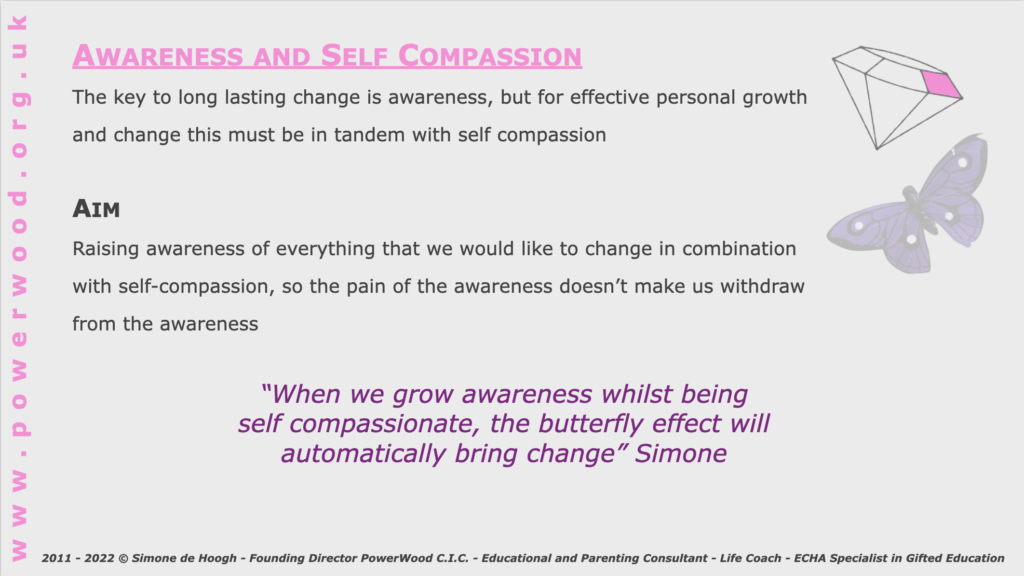
Raising Awareness and Compassion
Only 10% of our minds is conscious, 90% is unconscious and choice is only possible when we are aware and we need to be conscious about anything we want to make a choice about.
Imagine if we are the captain of a ship, and we are not aware of what’s going on in the rest of the ship, someone might dig a hole in the cargo hold or the engine room is at the verge of exploding. How are we going to make sure that this ship is sailing towards our aims if everything below little wheelhouse on the top deck is in our subconscious.
So many things can go wrong. We’ll probably crash…
There is no change possible without awareness. The first step towards change is to grow awareness and appreciating ourselves for that. In this facet we start using the Raising Awareness Process to focus on growing awareness. Our aim is to become aware of everything that we want to change.
In this facet we refocus from goal-oriented to process oriented.
When my daughter was eight months old, she found a sandwich with peanut butter on the table and tried to put it in the VHS video slide. My daughter didn’t do anything wrong, she was just exploring her environment with the intrinsic motivation that every child has innately that will drive them to learn everything they need to learn.
Before I knew it I was shouting at my daughter and I nearly pulled her physically aggressive away from the situation.
This experience with my daughter made me revisit my own runway. Where did this reaction come from? It must have been evolutionarily defined because it went against everything I made a conscious decision about: we wouldn’t shout nor hit our children.
How was I raised? I found out that my parents followed one of the most common parenting advisors of their time, and he advised to scare the… Out of children by raising your voice and hitting before they were four years old, so they would never hold it against the parent because they wouldn’t remember it later. Children brought up like this would be perfectly conditioned to fear you enough to just follow your lead and behave.
Our aim is to get in charge of our Stress Responses and the Involuntary Mechanisms, although developed to give ourselves the best possible start in life, can become in later life, when we don’t need them any more, a hindrance in achieving our personal goals.
This part of the journey can be challenging as it can be painful to become aware of how we have been (often not in a helpful way) influenced by the behaviour of our parents, how they have been influenced by the behaviour of their parents etc. etc. and how our own behaviour influences our child and the relationship dynamic so it is extremely important to be kind to yourself and keep the Baseline strong. You are the best person you can be at this moment and that is good enough!
We don’t have to work hard, we just raise awareness. We can trust the process, we don’t make any demands on ourselves nor expect to make any changes or improvements, we just focus on growing awareness, and the change will cascade down as part of the awareness.
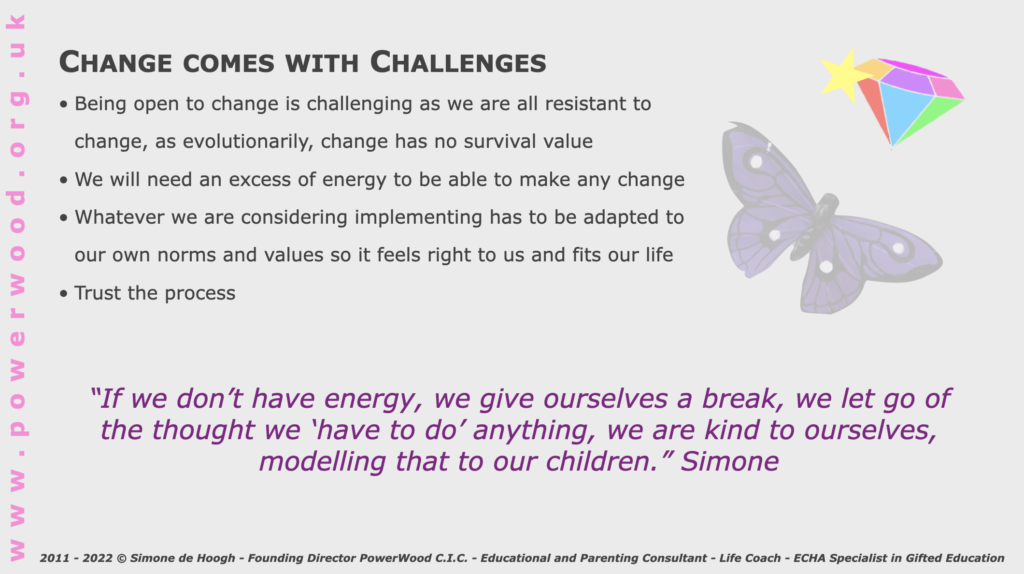
Good luck on your Journey!
The MERT is giving understanding, practical tools and strategies to apply in the moment to prevent escalation and help strengthening the Baseline.
Read Simone’s blog about ‘Upping’ your Baseline
Top 3 Tips to Up your Baseline (Energy and Resilience Level)
PowerWood’s Community
Find understanding, tools and strategies that work in an understanding, respectful and compassionate Community.
PowerWood can be your and your families advocate and your second family.
Explore how joining our PowerWood community by becoming a member will benefit you and your family and what types of memberships are available.
Join our Community
Available to Members*
*Booking a one-off Free Introductory Talk of 45-60 minutes by Skype or FaceTime with Senior Consultant Simone de Hoogh is one of the benefits of being either a FreeBee PowerWood Community Member or a Friend PowerWood Community Member.
Book a FREE Introductory Talk with a Professional*
You can read more about PowerWood’s Consultancy Sessions, the Benefits of a Free Introductory Talk and PowerWood’s Consultancy Services Tiered Fee Structure.
*Overexcitability Test
OE (Overexcitability) is an element of a Developmental Theory –Theory of Positive Disintegration by Dabrowski- that is one of the underpinning theories of MERT (Multi-level Emotion Regulation Theory) developed by Simone de Hoogh. Overexcitability explains and allows us to look at ‘extreme’ behaviour as a valuable asset in our or our children’s life.
Find out if you or your child has OE (OverExcitability) as well
*Boundary Test
A HUGE thank YOU to the son and daughter of Ernest Hartmann’s who gave PowerWood permission to use and put the full academically approved questionnaire about the Boundary in the Mind on PowerWood’s website.
Find out how the Boundary in the Mind affects you or your child

